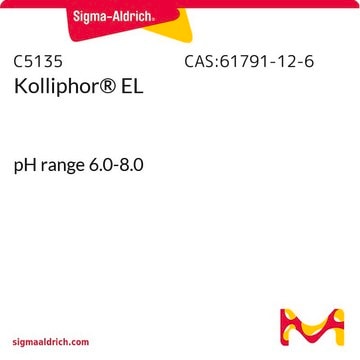Products may be shipped at a different temperature than the recommended long-term storage temperature. If the product quality is sensitive to short-term exposure to conditions other than the recommended long-term storage, it will be shipped on wet or dry-ice. If the product quality is NOT affected by short-term exposure to conditions other than the recommended long-term storage, it will be shipped at ambient temperature. As shipping routes are configured for minimum transit times, shipping at ambient temperature helps control shipping costs for our customers. For more information, please refer to the Storage and Transport Conditions document: https://www.sigmaaldrich.com/deepweb/assets/sigmaaldrich/marketing/global/documents/316/622/storage-transport-conditions-mk.pdf
15759
Poloxamer 188
Synonym(s):
Poly(ethylene glycol)-block-poly(propylene glycol)-block-poly(ethylene glycol), Lutrol F68
About This Item
Recommended Products
form
solid
Quality Level
mol wt
~7680-9510 g/mol
composition
oxyethylene, 79.9-83.7%
impurities
≤0.25% ethylene glycol and diethylene glycol
≤0.4% total ash
≤1 ppm ethylene oxide
≤1.0% water
≤2 ppm arsenic traces
≤20 ppm heavy metals
≤5 ppm dioxan
≤5 ppm propylene oxide
50-150 ppm butylhydroxytoluene
ign. residue
≤0.30%
color
APHA: ≤120, 50/50 in CH3OH
pH
5.0-7.5 (100 g/L in H2O)
6.0-7.5 (25 g/L in H2O)
CMC
0.48 mM
transition temp
cloud point >100 °C
HLB
>24
SMILES string
O2C(C2)C.O1CC1
InChI
1S/C3H6O.C2H4O/c1-3-2-4-3;1-2-3-1/h3H,2H2,1H3;1-2H2
InChI key
RVGRUAULSDPKGF-UHFFFAOYSA-N
Looking for similar products? Visit Product Comparison Guide
Application
- Stabilizing Function of P 188 in Dermal Formulations: Examined for its stabilizing effects on industrial concentrates of dermal hesperidin smartCrystals, P 188 contributed to enhancing the long-term stability of the formulations, relevant for dermal therapeutic interventions (Romero et al., 2015).
Biochem/physiol Actions
Other Notes
Legal Information
Storage Class Code
11 - Combustible Solids
WGK
WGK 1
Choose from one of the most recent versions:
Already Own This Product?
Find documentation for the products that you have recently purchased in the Document Library.
Customers Also Viewed
-
How is shipping temperature determined? And how is it related to the product storage temperature?
1 answer-
Helpful?
-
-
How can I determine the shelf life / expiration / retest date of this product?
1 answer-
If this product has an expiration or retest date, it will be shown on the Certificate of Analysis (COA, CofA). If there is no retest or expiration date listed on the product's COA, we do not have suitable stability data to determine a shelf life. For these products, the only date on the COA will be the release date; a retest, expiration, or use-by-date will not be displayed.
For all products, we recommend handling per defined conditions as printed in our product literature and website product descriptions. We recommend that products should be routinely inspected by customers to ensure they perform as expected.
For products without retest or expiration dates, our standard warranty of 1 year from the date of shipment is applicable.
For more information, please refer to the Product Dating Information document: https://www.sigmaaldrich.com/deepweb/assets/sigmaaldrich/marketing/global/documents/449/386/product-dating-information-mk.pdfHelpful?
-
Active Filters
Our team of scientists has experience in all areas of research including Life Science, Material Science, Chemical Synthesis, Chromatography, Analytical and many others.
Contact Technical Service





